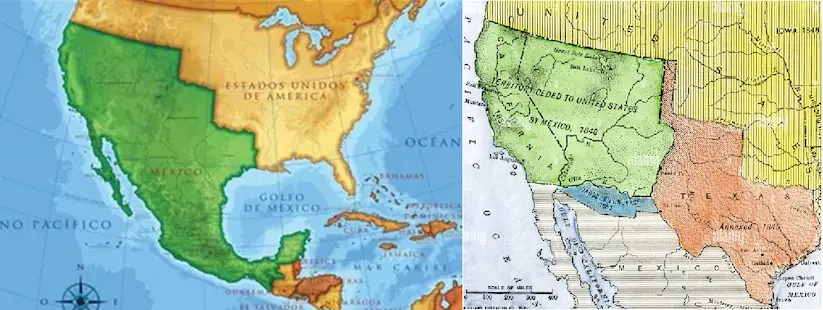
In 1848, the Treaty of Guadalupe Hidalgo ended the Mexican-American War and transferred over half of Mexico’s territory to the U.S. for $15 million
A War Ends, a Continent Transforms
The Treaty That Changed the West – On February 2, 1848, in the town of Guadalupe Hidalgo near Mexico City, a treaty was signed that would forever alter the map of North America. The Treaty of Guadalupe Hidalgo officially ended the Mexican-American War (1846–1848) and transferred an astonishing 55% of Mexico’s territory to the United States. In exchange, the U.S. paid $15 million and agreed to settle over $3 million in claims by American citizens against Mexico.
The land ceded under the treaty included what are now the states of California, Nevada, Utah, most of Arizona and New Mexico, and parts of Colorado, Wyoming, Kansas, and Oklahoma. It also confirmed the Rio Grande as the southern border of Texas, a point of contention that had helped ignite the war in the first place.
This monumental agreement was more than a land deal it was the culmination of Manifest Destiny, the 19th-century belief that the United States was destined to expand across the continent. For Mexico, it was a devastating loss that triggered political instability and national soul-searching. For the U.S., it was a leap toward continental dominance.
The Price of Expansion: $15 Million and a Diplomatic Gamble
The $15 million paid to Mexico may seem like a bargain by today’s standards, but it was a significant sum in 1848. The payment was framed as compensation “in consideration of the extension acquired by the boundaries of the United States,” though many critics argued it was little more than a fig leaf for conquest.
The treaty was negotiated by Nicholas Trist, a U.S. diplomat who defied President James K. Polk’s orders to return home and instead struck a deal with Mexico’s weakened government. Trist believed that prolonging the war would only deepen the suffering on both sides. His gamble paid off though Polk was furious, the U.S. Senate ratified the treaty in March 1848.
The agreement also included provisions for the civil rights of Mexicans living in the newly acquired territories, offering them the choice to relocate or become U.S. citizens. While these promises were made on paper, the reality was often far more complicated, with many facing discrimination and land dispossession in the years that followed.
Legacy and Controversy: A Deal That Still Echoes
The Treaty of Guadalupe Hidalgo remains one of the most consequential—and controversial agreements in American history. It completed the continental expansion of the United States, setting the stage for the Gold Rush, the rise of the American West, and the eventual Civil War, as new territories reignited fierce debates over slavery.
For Mexico, the treaty was a national trauma. The loss of territory and pride fueled decades of political unrest and civil war. In the U.S., the acquisition was celebrated by expansionists but condemned by Whigs and abolitionists who saw it as an unjust war of aggression.
The treaty’s legacy is still felt today in the cultural and demographic fabric of the American Southwest. Cities like Los Angeles, San Antonio, and Santa Fe bear the imprint of their Mexican heritage, even as they exist within U.S. borders. The treaty also laid the groundwork for future disputes, including the Gadsden Purchase of 1853, which added more land to the U.S. and further strained relations between the two nations. In retrospect, the $15 million land deal was not just a transaction—it was a turning point. It redrew borders, redefined identities, and reshaped the destiny of two nations. And while the ink has long dried on the Treaty of Guadalupe Hidalgo, its impact continues to ripple through history.
Stay updated with the latest news on Rapido Updates. Keep yourself updated with The World, India News, Entertainment, Market, Gadgets, Sports, and many more
1 thought on “The Treaty That Changed the West: Inside the $15 Million U.S.-Mexico Land Deal”